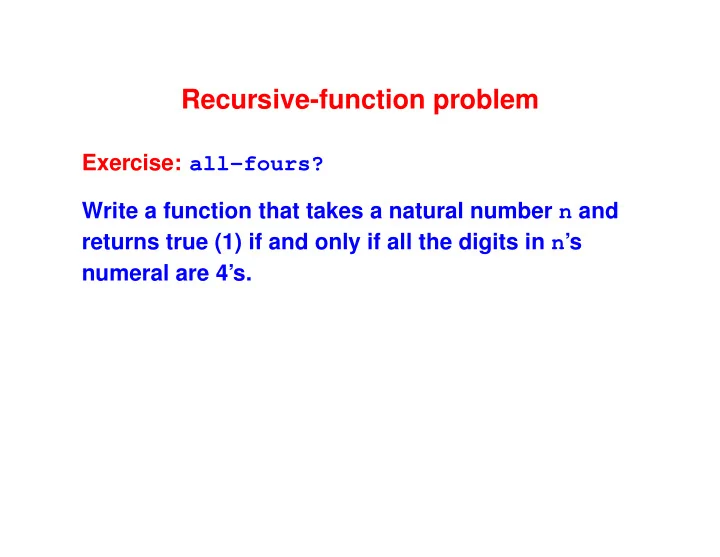

Recursive-function problem Exercise: all-fours? Write a function that takes a natural number n and returns true (1) if and only if all the digits in n ’s numeral are 4’s.
Key design step: Form of number Choose inductive structure for natural numbers: • Which case analysis do we want? Step 1: Forms of DECNUMERAL proof system (1st lesson in program design): • Either a single digit d • Or 10 + d , where m � m 6 = 0
Example inputs Step 2: • Single digits: 4 , 9 • Multi-digits: 44 , 907 , 48
Function’s name and contract Steps 3 and 4: Function (all-fours? n) returns nonzero if and only if the decimal representation of n can be written using only the digit 4 .
Example results Step 5: write expected results as unit tests: (check-assert (all-fours? 4)) (check-assert (not (all-fours? 9))) (check-assert (all-fours? 44)) (check-assert (not (all-fours? 48))) (check-assert (not (all-fours? 907)))
Algebraic laws Step 6: Generalize example results to arbitrary forms of data (all-fours? d) == (= d 4) (all-fours? (+ (* 10 m) d)) == (= d 4) && (all-fours? m)
Left-hand sides turn into case analysis Step 7: ; (all-fours? d) == ... ; (all-fours? (+ (* 10 m) d)) == ... (define all-fours? (n) (if (< n 10) ... case for n = d ... ... case for n = (+ (* 10 m) d), so m = (/ n 10) and d = (mod n 10) ...))
Each right-hand side becomes a result Step 8: ; (all-fours? d) == (= d 4) ; (all-fours? (+ (* 10 m) d)) == ; (= d 4) && (all-fours? m) (define all-fours? (n) (if (< n 10) (= n 4) (and (= 4 (mod n 10)) (all-fours? (/ n 10)))))
Revisit tests: Step 9: (check-assert (all-fours? 4)) (check-assert (not (all-fours? 9))) (check-assert (all-fours? 44)) (check-assert (not (all-fours? 907))) (check-assert (not (all-fours? 48))) Checklist: • For each form of data, one true and one false • One extra corner case ( partly fours) • Tests pass
Idea of LISP syntax Parenthesized prefix syntax: • Names and numerals are basic atoms • Other constructs bracketed with ( . . . ) or [ . . . ] (Possible keyword after opening bracket) Examples: (+ 2 2) (if (isbound? x rho) (lookup rho x) (error 99)) (For now, we use just the round brackets)
Impcore structure Two syntactic categories: expressions, definitions No statements!—expression-oriented (compositional) (if e1 e2 e3) (while e1 e2) (set x e) (begin e1 ... en) (f e1 ... en) Evaluating e has value, may have side effects Functions f named (e.g., + - * / = < > print ) The only type of data is “machine integer” (deliberate oversimplification)
Syntactic structure of Impcore An Impcore program is a sequence of definitions (define mod (m n) (- m (* n (/ m n)))) Compare int mod (int m, int n) { return m - n * (m / n); }
Impcore variable definition Example (val n 99) Compare int n = 99;
Concrete syntax for Impcore Definitions and expressions: def ::= (define f (x1 ... xn) exp) ;; "true" defs | (val x exp) | exp | (use filename) ;; "extended" defs | (check-expect exp1 exp2) | (check-assert exp) | (check-error exp) exp ::= integer-literal | variable-name | (set x exp) | (if exp1 exp2 exp3) | (while exp1 exp2) | (begin exp1 ... expn) | (function-name exp1 ... expn)
Recommend
More recommend